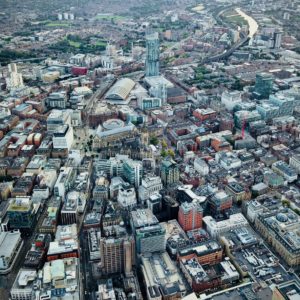Manchester is a vibrant city known for its industrial heritage, thriving music scene, and passionate sports culture. As a local team of private investigators based in Manchester, we love this city dearly.
However, like any major city, it isn’t exempt from criminal activities. In this article, we will explore the overall crime statistics in Manchester, examine the crime rates in different areas, consider the underlying socio-economic factors contributing to crime, and discuss preventative measures against crime.
Overall crime statistics in Manchester
According to UK Crime Statistics taken between Aug 2018 – Aug 2022, the most prolific type of crime in Manchester during that period was violent crime, with 97,948 cases. Coming in second was anti-social behaviour with 56,571 cases. Here are the other categories in descending order.
- Public order – 36,726
- Criminal damage and arson – 31,442
- Vehicle crime – 29,149
- Burglary – 26,691
- Other theft – 24,290
- Shoplifting – 16,065
- Other crime – 7,040
- Theft from the person – 6,888
- Robbery – 6,744
- Drugs – 5,714
- Bike theft – 3,488
One source tracking the number of police-recorded offences by Greater Manchester Police from 2015-2022 found that crime in Manchester was at its lowest rate between 2015-2016, with 225,407 offences. The highest point was 2021-2022 with 361,018 offences.
According to the data, there was a steady rise between 2015-2016 – 2017-2018. Following a slight dip in 2018-2019, police reported that crime fell to its lowest during the height of the Coronavirus Pandemic in 2019-2020, and it has grown ever since.
Manchester crime rates by area
Below, we’ve put together a chart showing the crime rates per area in Greater Manchester. Figures are per thousand residents in 2022, using data from the Office of National Statistics and Greater Manchester Police.
| Area | Crime Rate |
| Manchester | 169.37 |
| Rochdale | 130.80 |
| Bolton | 127.03 |
| Oldham | 124.72 |
| Salford | 122.99 |
| Tameside | 119.14 |
| Wigan | 113.14 |
| Bury | 110.20 |
| Stockport | 88.24 |
| Trafford | 83.69 |
From these figures, you can see that central Manchester holds the highest crime rate of the areas taken into consideration. However, the source notes other factors that may play into this such as a large police presence and CCTV coverage which may lead to a disproportionate rate of offences being recorded by the police.
A closer look at the statistics
It is important to note that criminal activity is unquestionably linked with socio-economic pressures. Poverty is accepted as one of, if not the main predictor of crime, so it is important to examine the rates of poverty and unemployment in a given area when seeking to understand the crime rates.
According to one article published in Manchester World in 2022, Greater Manchester “has a higher unemployment rate than the national average and unemployment has risen more markedly in the city-region since 2019 compared to England as a whole.”
The same source notes that the rates of child poverty were high, with 1 in four young people (144,770 children) living in poverty. When these factors are taken into consideration, it is easier to understand the rising rates of crime in Manchester.
Preventative measures against crime in Manchester
‘Greater Manchester’s plan for safer, stronger communities’ was published in 2018. It states that since 2010, more than £200 million in cuts had been made to Greater Manchester Police by the central government.
It underlines that the police force “can’t act alone” in its efforts to tackle to the ever-evolving crime culture in Manchester and that it would “require a response not just from the police, but from all public agencies, the voluntary sector, and local people.”
As such, the report lists a series of attitudes and initiatives intended to tackle varying sectors of crime. The City of Manchester also has a series of programs intended to better educate its citizens on different forms of crime and crime prevention.
Crime in Manchester – a summary
Manchester has a higher-than-average crime rate that appears to be on the rise. What’s more, despite increasing pressures on Greater Manchester Police, they seem ill-equip to tackle the underlying socio-economic factors linked to the rising crime rate. Factors such as poverty and unemployment play crucial roles in the issue and need to be addressed holistically.


